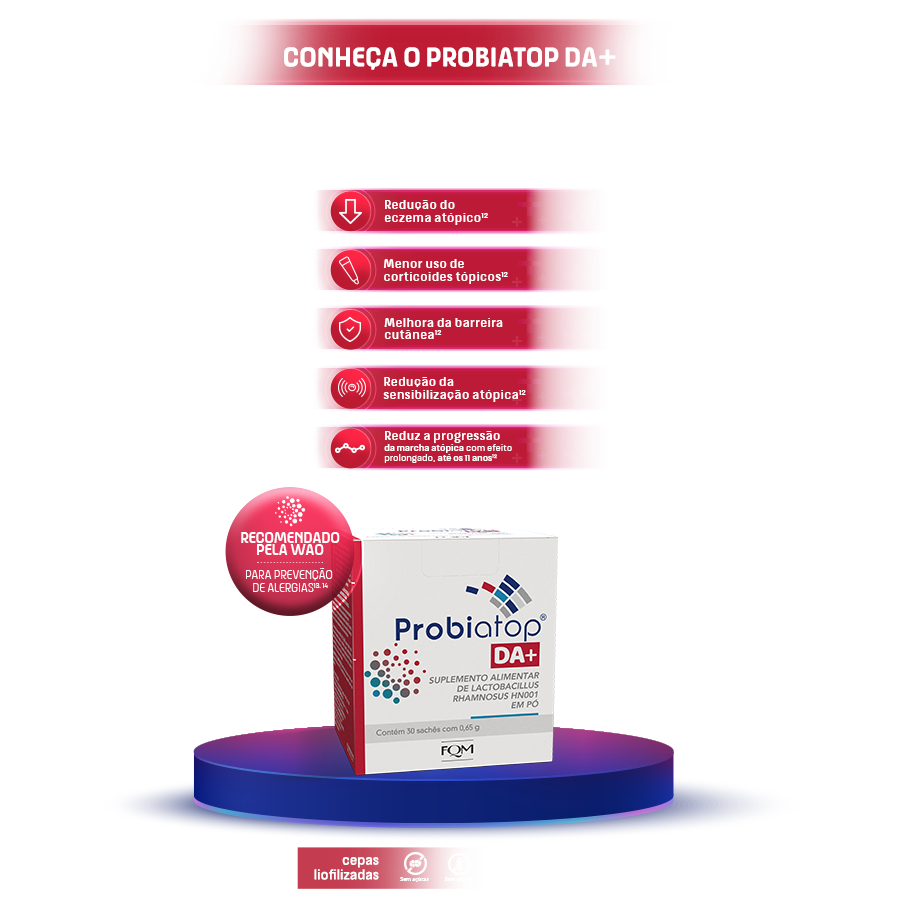

REFERÊNCIAS:
1.Guarner, F., Sanders, M. E., Szajewska, H., Cohen, H., Eliakim, R., Herrera, C., Karakan, T., Merenstein, D., Piscoya, A., Ramakrishna, B., & Seppo Salminen. (2023a). World Gastroenterology Organisation Global Guidelines Probiotics and prebiotics. 2.Rowland I, Capurso L, Collins K, Cummings J, Delzenne N, Goulet O, Guarner F, Marteau P, Meier R. Current level of consensus on probiotic science report of an expert meeting London, 23 November 2009. Gut Microbe. 2010;1(6):436e9. 3.Chapman CMC, Gibson GR, Rowland I. In vitro evaluation of single-and multi-strain probiotics: Inter-species inhibition between probiotic strains, and inhibition of pathogens. Anaerobe. 2012; 18: 405-413. 4. Drago L, Gismondo MR, Lombardi A, de Haen C, Gozzini L. Inhibition of in vitro growth of enteropathogens by new Lactobacillus isolates of human intestinal origin. FEMS Microbiol Lett. 1997;153(2):455-63. 5. ARAÚJO, Paula Gonçalves de et al. Efeito de uma associação de cepas probióticas contendo lactobacillus e bifidobacterium na modulação da microbiota intestinal em pacientes constipados. GED gastroenterol. endosc. dig, p. 89-98, 2017. 6. Probiatop. Embalagem do produto. 7. Tsuge M, Ikeda M, Matsumoto N, Yorifuji T, Tsukahara H. Current insights into atopic march. Children (Basel). 2021;8(11):1067. 8. Paixão LA, dos Santos Castro FF. Colonização da microbiota intestinal e sua influência na saúde do hospedeiro. Universitas Ciênc Saúde. 2016;14(1):85-96. 9. Abrahamsson TR, Jakobsson HE, Andersson AF, Björkstén B, Engstrand L, Jenmalm MC. Low Diversity of the Gut Microbiota in Infants with Atopic Eczema. J Allergy Clin Im`):434-40, 440.e1-2. 10. Song H, Yoo Y, Hwang J, Na YC, Kim HS. Faecalibacterium prausnitzii subspecies-level dysbiosis in the human gut microbiome underlying atopic dermatitis. J. Allergy Clin. Immunol. 2016;137(3):852-60. 11. Addor FAS. Melhora clínica da dermatite atópica em crianças de 6 meses a 12 anos com o uso oral de uma associação de probióticos. Arqu Asma Alergia Imunol. 2015;3(3):99-105. 12. Wickens, K., Barthow, C., Mitchell, E. A., Kang, J., van Zyl, N., Purdie, G., & Crane, J. (2018). Effects of Lactobacillus rhamnosus HN001 in early life on the cumulative prevalence of allergic disease to 11 years. Pediatric Allergy and Immunology, 29(8), 808-814. 13. Probiatop DA+. Embalagem do produto. 14. FIOCCHI, Alessandro, et al. World allergy organization McMaster University guidelines for allergic disease prevention (GLAD-P): probiotics. World Allergy Organization Journal, 2015, 8.1: 1-13. 15. GUARNER, F. et al. Diretrizes Mundiais da Organização Mundial de Gastroenterologia. Probióticos e prebióticos, 2011. Meyer, D., Stasse-Wolthuis, M. The bi-dogenic e ect of inulin and oligofructose and its consequences for gut health. Eur J Clin Nutr 63, 1277–1289 (2009). 16. Walker CL, Black RE. Zinc for the treatment of diarrhoea: effect on diarrhoea morbidity, mortality and incidence of future episodes. Int J Epidemiol. 2010;39 (Suppl 1): i63-9. 17. Wang, Y., Xiao, J., Wei, S., Su, Y., Yang, X., Su, S., … & Shan, Q. (2024). Protective effect of zinc gluconate on intestinal mucosal barrier injury in antibiotics and LPS-induced mice. 18. Markowiak, P.; Slizewska, K. The role of probiotics, prebiotics and synbiotics in animal nutrition. Gut Pathog. 2018, 10, 21. 19. Guarino, M.P.L.; Altomare, A.; Emerenziani, S.; Di Rosa, C.; Ribolsi, M.; Balestrieri, P.; Iovino, P.; Rocchi, G.; Cicala, M. Mechanisms of Action of Prebiotics and Their Effects on Gastro-Intestinal Disorders in Adults. Nutrients 2020, 12, 1037. 20. Du, H.P.; Zhao, A.Q.; Wang, Q.; Yang, X.B.; Ren, D.Y. Supplementation of Inulin with Various Degree of Polymerization Ameliorates Liver Injury and Gut Microbiota Dysbiosis in High Fat-Fed Obese Mice. J. Agr. Food Chem. 2020, 68, 779–787. 21. PATEL, Rachna; DUPONT, Herbert L. New approaches for bacteriotherapy: prebiotics, new-generation probiotics, and synbiotics. Clinical Infectious Diseases, 2015, 60.suppl_2: S108-S121. 22. Canani, R. B., Buccigrossi, V., & Passariello, A. (2011). Mechanisms of action of zinc in acute diarrhea. Current Opinion in Gastroenterology, 27(1), 8–12. https://doi.org/10.1097/MOG.0b013e32833fd48a. 23. Chen, Q., Wang, P., Wang, J., Xu, J., Liu, C., Qiao, H., … & Li, L. (2022). Zinc laurate protects against intestinal barrier dysfunction and inflammation induced by ETEC in a mice model. Nutrients, 15(1), 54. 24. TOMAR, Sudhir Kumar, et al. Role of probiotics, prebiotics, synbiotics and postbiotics in inhibition of pathogens. The Battle against Microbial Pathogens: Basic Science, Technological Advances and Educational Programs; Méndez-Vilas, A., Ed, 2015, 717-732. 25. Simbioflora. Embalagem do produto. 26. Simbioflora MULTI. Embalagem do produto. 27. Ouwehand, A., & Lahtinen, S. (2009). HANDBOOK OF PROBIOTICS AND PREBIOTICS. 28. Yoo, S., Jung, S. C., Kwak, K., & Kim, J. S. (2024). The role of prebiotics in modulating gut microbiota: implications for human health. International Journal of Molecular Sciences, 25(9), 4834. 29. HUGHES Riley L., et al. The prebiotic potential of inulin-type fructans: a systematic review. Advances in Nutrition, 2022;13(2):492–539.
MINI BULAS:
PROBIATOP SACHÊS
SUPLEMENTO ALIMENTAR EM PÓ. É composto por uma formulação de Lactobacillus acidophilus, Lactobacillus rhamnosus, Lactobacillus paracasei e Bifidobacterium lactis (probióticos) em pó. Lactobacillus acidophilus, Lactobacillus rhamnosus, Lactobacillus paracasei e Bifidobacterium lactis contribuem para o equilíbrio da flora intestinal. Seu consumo deve estar associado a uma alimentação equilibrada e hábitos de vida saudáveis. Consumir somente a quantidade indicada na embalagem. Gestantes, nutrizes e crianças somente devem consumir esse produto sob orientação de nutricionista ou médico. O CONSUMO DESTE PRODUTO DEVE SER ACOMPANHADO DA INGESTÃO DE LÍQUIDOS. NÃO CONTÉM GLÚTEN. Alimento notificado na Anvisa: 25351.429963/2024-18
PROBIATOP COMPRIMIDOS
Suplemento alimentar em comprimido. Bifidobacterium animalis subespécie lactis HN019, Lactobacillus acidophilus NCFM, Lactobacillus rhamnosus HN001, Lactobacillus paracasei Lpc-37 podem contribuir com a saúde do trato gastrointestinal. ESTE PRODUTO NÃO É UM MEDICAMENTO. NÃO EXCEDER A RECOMENDAÇÃO DIÁRIA DE CONSUMO INDICADA NA EMBALAGEM. MANTENHA FORA DO ALCANCE DE CRIANÇAS. O produto não deve ser utilizado por pessoas imunocomprometidas (seja por uma condição de doença ou pelo uso de medicação imunossupressora) ou por pessoas acometidas de condição de saúde debilitante grave. NÃO CONTÉM GLÚTEN. Alimento notificado na Anvisa: 25351.430556/2024-53.
PROBIATOP DA+
Suplemento alimentar de Lactobacillus rhamnosus HN001 em pó. O Lactobacillus rhamnosus HN001 (ATCC SD5675) pode reduzir o risco de eczema (dermatite atópica) na infância, quando administrado a gestantes e lactantes, desde a 35ª semana de gestação até o 6º mês de amamentação, e aos seus filhos, lactentes de alto risco, desde o nascimento até os dois anos de idade. ESTE PRODUTO NÃO É UM MEDICAMENTO. NÃO EXCEDER A RECOMENDAÇÃO DIÁRIA DE CONSUMO INDICADA NA EMBALAGEM. MANTENHA FORA DO ALCANCE DE CRIANÇAS. O produto não deve ser consumido por pessoas imunocomprometidas ou pessoas acometidas de condição de saúde debilitante grave. O produto deve ser usado por gestantes e lactantes, desde a 35ª semana de gestação até o 6º mês de amamentação, e aos seus filhos, lactentes de alto risco, desde o nascimento até os dois anos de idade. NÃO CONTÉM GLÚTEN. Reg. MS. 6.7239.0024.
SIMBIOFLORA
SUPLEMENTO ALIMENTAR EM PÓ.É composto por uma formulação de frutooligossacarídeo (prebiótico), Lactobacillus acidophilus, Lactobacillus rhamnosus, Lactobacillus paracasei e Bifidobacterium lactis (probióticos) em pó. Lactobacillus acidophilus, Lactobacillus rhamnosus, Lactobacillus paracasei e Bifidobacterium lactis contribuem para o equilíbrio da flora intestinal. Seu consumo deve estar associado a uma alimentação equilibrada e hábitos de vida saudáveis. Consumir somente a quantidade indicada na embalagem. Gestantes, nutrizes e crianças somente devem consumir esse produto sob orientação de nutricionista ou médico. O CONSUMO DESTE PRODUTO DEVE SER ACOMPANHADO DA INGESTÃO DE LÍQUIDOS. NÃO CONTÉM GLÚTEN. Alimento notificado na Anvisa: 25351.432339/2024-06.
SIMBIOFLORA MULTI
Suplemento alimentar em pó. O Lactobacillus acidophilus NCFM (ATCC SD5221) e o Bifidobacterium animalis subsp. lactis HN019 (ATCC SD5674) podem contribuir com a saúde do trato gastrointestinal. ESTE PRODUTO NÃO É UM MEDICAMENTO. NÃO EXCEDER A RECOMENDAÇÃO DIÁRIA DE CONSUMO INDICADA NA EMBALAGEM. MANTENHA FORA DO ALCANCE DE CRIANÇAS. Este produto não deve ser consumido por gestantes, lactantes, lactentes, crianças, pessoas imunocomprometidas ou pessoas acometidas de condição de saúde debilitante grave. NÃO CONTÉM GLÚTEN. Reg. MS. 6.7239.0023.


